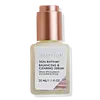What's inside
What's inside
 Key Ingredients
Key Ingredients

 Benefits
Benefits

 Concerns
Concerns

 Ingredients Side-by-side
Ingredients Side-by-side

Water
Skin ConditioningTetrahexyldecyl Ascorbate
AntioxidantSqualane
EmollientPolyglyceryl-6 Distearate
EmulsifyingPEG-8 Beeswax
EmulsifyingPPG-12/Smdi Copolymer
EmollientGlycine Soja Sterols
EmollientSodium Phytate
Tocopherol
AntioxidantAcetamidoethoxyethanol
HumectantHydroxyethyl Acrylate/Sodium Acryloyldimethyl Taurate Copolymer
Emulsion StabilisingSodium Acrylate/Sodium Acryloyldimethyl Taurate Copolymer
Emulsion StabilisingJojoba Esters
EmollientGlycolic Acid
BufferingCaprylyl Glycol
EmollientCetyl Alcohol
EmollientPolyglyceryl-3 Beeswax
EmulsifyingChlorphenesin
AntimicrobialGlycerin
HumectantPolysorbate 60
EmulsifyingSorbitan Isostearate
EmulsifyingSaccharide Isomerate
HumectantCitrus Aurantium Dulcis Peel Oil
MaskingCitrus Tangerina Peel Oil
MaskingLinalool
PerfumingLimonene
PerfumingPhenoxyethanol
PreservativeWater, Tetrahexyldecyl Ascorbate, Squalane, Polyglyceryl-6 Distearate, PEG-8 Beeswax, PPG-12/Smdi Copolymer, Glycine Soja Sterols, Sodium Phytate, Tocopherol, Acetamidoethoxyethanol, Hydroxyethyl Acrylate/Sodium Acryloyldimethyl Taurate Copolymer, Sodium Acrylate/Sodium Acryloyldimethyl Taurate Copolymer, Jojoba Esters, Glycolic Acid, Caprylyl Glycol, Cetyl Alcohol, Polyglyceryl-3 Beeswax, Chlorphenesin, Glycerin, Polysorbate 60, Sorbitan Isostearate, Saccharide Isomerate, Citrus Aurantium Dulcis Peel Oil, Citrus Tangerina Peel Oil, Linalool, Limonene, Phenoxyethanol
Water
Skin ConditioningPropylene Glycol
HumectantGlycerin
HumectantDicaprylyl Carbonate
EmollientDiheptyl Succinate
EmollientC14-22 Alcohols
Emulsion StabilisingCapryloyl Glycerin/Sebacic Acid Copolymer
Skin ConditioningSalix Alba Bark Extract
AstringentMandelic Acid
AntimicrobialAzelaic Acid
BufferingNiacinamide
SmoothingUbiquinone
AntioxidantSebacic Acid
BufferingTetrahexyldecyl Ascorbate
AntioxidantTocopheryl Acetate
AntioxidantAcrylates/Vinyl Isodecanoate Crosspolymer
Emulsion StabilisingPentylene Glycol
Skin ConditioningC12-20 Alkyl Glucoside
EmulsifyingCaprylyl Glycol
EmollientC12-15 Alkyl Benzoate
AntimicrobialMelia Azadirachta Flower Extract
Skin ConditioningMelia Azadirachta Leaf Extract
Skin ConditioningOcimum Sanctum Leaf Extract
Skin ConditioningCurcuma Longa Root Extract
MaskingOcimum Basilicum Flower/Leaf Extract
TonicCorallina Officinalis Extract
Skin ConditioningPropanediol
SolventEthylhexylglycerin
Skin ConditioningSodium Hydroxide
BufferingWater, Propylene Glycol, Glycerin, Dicaprylyl Carbonate, Diheptyl Succinate, C14-22 Alcohols, Capryloyl Glycerin/Sebacic Acid Copolymer, Salix Alba Bark Extract, Mandelic Acid, Azelaic Acid, Niacinamide, Ubiquinone, Sebacic Acid, Tetrahexyldecyl Ascorbate, Tocopheryl Acetate, Acrylates/Vinyl Isodecanoate Crosspolymer, Pentylene Glycol, C12-20 Alkyl Glucoside, Caprylyl Glycol, C12-15 Alkyl Benzoate, Melia Azadirachta Flower Extract, Melia Azadirachta Leaf Extract, Ocimum Sanctum Leaf Extract, Curcuma Longa Root Extract, Ocimum Basilicum Flower/Leaf Extract, Corallina Officinalis Extract, Propanediol, Ethylhexylglycerin, Sodium Hydroxide
 Reviews
Reviews

Ingredients Explained
These ingredients are found in both products.
Ingredients higher up in an ingredient list are typically present in a larger amount.
Caprylyl Glycol is a humectant and emollient, meaning it attracts and preserves moisture.
It is a common ingredient in many products, especially those designed to hydrate skin. The primary benefits are retaining moisture, skin softening, and promoting a healthy skin barrier.
Though Caprylyl Glycol is an alcohol derived from fatty acids, it is not the kind that can dry out skin.
This ingredient is also used as a preservative to extend the life of products. It has slight antimicrobial properties.
Learn more about Caprylyl GlycolGlycerin is already naturally found in your skin. It helps moisturize and protect your skin.
A study from 2016 found glycerin to be more effective as a humectant than AHAs and hyaluronic acid.
As a humectant, it helps the skin stay hydrated by pulling moisture to your skin. The low molecular weight of glycerin allows it to pull moisture into the deeper layers of your skin.
Hydrated skin improves your skin barrier; Your skin barrier helps protect against irritants and bacteria.
Glycerin has also been found to have antimicrobial and antiviral properties. Due to these properties, glycerin is often used in wound and burn treatments.
In cosmetics, glycerin is usually derived from plants such as soybean or palm. However, it can also be sourced from animals, such as tallow or animal fat.
This ingredient is organic, colorless, odorless, and non-toxic.
Glycerin is the name for this ingredient in American English. British English uses Glycerol/Glycerine.
Learn more about GlycerinTetrahexyldecyl Ascorbate (THD) is a stable and oil-soluble form of Vitamin C.
THD is special in that it has the ability to travel deeper into skin than traditional ascorbic acid while maintaining the same skin benefits (double win!).
Because it’s oil-soluble, THD dives deep into your skin’s fatty layers (think ceramides and cholesterol) to fight off the kind of free radicals that mess with your skin barrier. This makes it a great pair with water-based vitamin C (ascorbic acid) that mainly works on the surface.
Even at just 0.1%, THD is already showing great antioxidant activity. When used up to 2%, it helps keep your skin happy and calm, especially when it’s stressed from pollution or sun.
Want to fade dark spots or tackle hyperpigmentation? You’ll want 5% or more. Pairing it with brightening buddies like niacinamide or licorice root gives even better results. One study even used 30% THD with other brighteners and saw real results on stubborn discoloration, even in melasma-prone skin.
A note on THD: It’s has a slightly silky, oily texture and usually shows up colorless or pale yellow (though the exact shade can vary by supplier).
While you can sneak it into water-based formulas, it really shines when paired with silicones or oils, which help your skin soak it up better.
THD is pretty stable, but it’s still vulnerable to degradation like ascorbic acid. Too much light or heat (above 113°F / 45°C) can break it down over time. Go for dark and opaque packaging that keeps it safe and shady!
Read more about other types of Vitamin C:
Learn more about Tetrahexyldecyl AscorbateWater. It's the most common cosmetic ingredient of all. You'll usually see it at the top of ingredient lists, meaning that it makes up the largest part of the product.
So why is it so popular? Water most often acts as a solvent - this means that it helps dissolve other ingredients into the formulation.
You'll also recognize water as that liquid we all need to stay alive. If you see this, drink a glass of water. Stay hydrated!
Learn more about Water